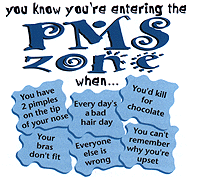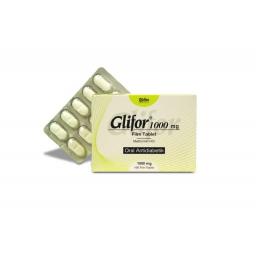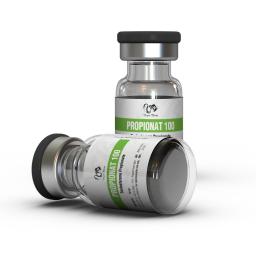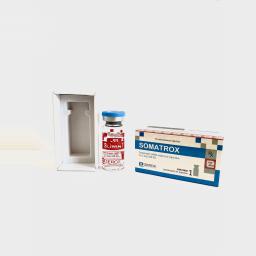What is premenstrual syndrome?
 Premenstrual Syndrome (PMS) occurs when a woman experiences recurrent symptoms in the seven to ten days before the period begins. Symptoms cease before or during the period, followed by a symptom-free week. Some women, however, experience symptoms from ovulation which may last until the next period commences.
Premenstrual Syndrome (PMS) occurs when a woman experiences recurrent symptoms in the seven to ten days before the period begins. Symptoms cease before or during the period, followed by a symptom-free week. Some women, however, experience symptoms from ovulation which may last until the next period commences.
PMS is more common in women over the age of 30, but can occur in younger women.
Not all women suffer PMS. Some suffer mild to moderate symptoms for a day or two only; however a small number of women (aboutfive per cent), suffer severe symptoms which interfere with their quality of life at some stage during their reproductive years.
What causes PMS?
The exact cause of PMS is not known but it is a complex condition involving hormones, brain chemicals, genetic, emotional, physical and environmental factors.
PMS only occurs in women who are ovulating with regular periods and normal levels of hormones – it is not a hormonal imbalance. Women who experience PMS appear to have an increased sensitivity to hormones, possibly more so to progesterone, affecting the brain chemicals. The most severe form of PMS in premenstrual dysphoric disorder (PMDD).
What are the most common symptoms?
Whilst many women do not suffer PMS, others may suffer one or more of the following symptoms:
Emotional Symptoms:
- Irritability
- Anxiety
- Nervous tension
- Mood swings
- Lower coping ability
- Depression
- Aggression
- Difficulty concentrating
- Lower libido, rarely increased libido
- Feeling unloved
- Wanting to be alone
- Reduced interest in work and social life
Physical symptoms:
- Fluid retention (swollen fingers or ankles)
- Bloating around the abdomen
- Breast swelling and tenderness
- Headaches ranging from mild to a severe migraine
- Tiredness, lethargy, insomnia
- Increase in weight
- Constipation
- Food cravings, especially sweet foods
- Aches and pains, particularly lower back, legs and abdomen
- Poor coordination or clumsiness
- Skin problems such as acne
- Occasionally increased energy
How do you tell if your symptoms are PMS?
Whether you suffer one or a few of the above symptoms, it is the timing of the symptoms that will indicate whether or not you are suffering PMS. Symptoms due to PMS will only occur after ovulation (mid-cycle) and will disappear during the next menstrual period. Mark your symptoms on a calendar or keep a daily menstrual chart over two to three months to help your doctor with the diagnosis.
Lifestyle factors that may help towards relieving your PMS symptoms
- Eat regular, healthy meals including plenty of vegetables, fruit, mixed grains and cereals.
- Eat small meals to maintain stable energy levels, this will also significantly reduce food cravings.
- Drink less caffeine – particularly if you are suffering breast tenderness. Try drinking water instead (six to eight glasses a day).
- Cut down on alcoholic beverages.
- Cut down on salt and salty foods to help reduce fluid retention.
- Get enough rest, sleep and exercise.
- Don’t smoke.
- Wear a well fitting cotton bra if you suffer from tense, painful breasts.
Physical activity
 Regular physical activity is important, particularly during the premenstrual phase. Walking is an excellent activity and has the advantage of being both cheap and easy for most people. Swimming, yoga, aerobics, netball, tennis, golf and cycling are other suggestions. Make sure you choose a form or variety of activities that you enjoy – otherwise you will not pursue it.
Regular physical activity is important, particularly during the premenstrual phase. Walking is an excellent activity and has the advantage of being both cheap and easy for most people. Swimming, yoga, aerobics, netball, tennis, golf and cycling are other suggestions. Make sure you choose a form or variety of activities that you enjoy – otherwise you will not pursue it.
Physical activity increases endorphins (one of the brain’s neurotransmitters, or chemicals, which may be altered premenstrually in PMS sufferers) and therefore may reduce symptoms. Endorphins also act as natural pain killers and help you to feel more relaxed and in control.
Reduce stress
- Make an effort to avoid extra stresses (mark your premenstrual time on the calendar so that you can avoid major activities)
- Talk to your family/friends about your PMS so they can have some understanding of the problem. Help them develop strategies to be supportive during this time
- Take time out to relax and enjoy your own interests
- Try to develop your positive thinking
- Seek professional counselling
If your PMS symptoms continue to distress you, consult your doctor. It is important that other possible causes of the symptoms are excluded. Although no cure can be offered there are many treatments that may help reduce and, for some women, completely alleviate PMS symptoms. It may be necessary to try different treatments before you find the most effective one for you.
Treatment of PMS
Natural therapies
Many women feel they benefit from a variety of natural therapies but none have been proven in controlled studies to be beneficial, their effects being no better than placebo, i.e. about 30-40 per cent reduction in symptoms.
Vitamin B6 (Pyridoxine) has been used to reduce emotional symptoms and fluid retention but in doses no greater than 50-100mg per day as high doses can lead to peripheral neuropathy (damage to the peripheral nerves) or loss of sensation in fingers and toes.
Evening primrose oil has been used to reduce breast tenderness in dosages up to 3000mg per day.
Calcium – 1200 mg per day.
St John’s Wort is a plant serotonin enhancer, which may reduce mood symptoms.
Other preparations such as Chaste Tree (also known as chaste berry) have also been used.
Talk to your doctor or naturopath about this group of medicines.
Hormonal therapies
The combined oral contraceptive pill (COCP) may be prescribed because it prevents ovulation and for some women this will provide relief from symptoms. The monophasic pill (with the same hormone dose in each active pill) is more beneficial than other types such as either the triphasic or biphasic pills.
Other hormone preparations have been tried such as progestins, progesterone and oestrogen preparations. Only oestrogen patches and implants have shown to be beneficial in controlled studies.
Selective Serotonin Reuptake Inhibitors (SSRIs)
SSRIs have been studied extensively in placebo-controlled trials and have shown significant benefit in reducing symptoms, particularly the emotional symptoms. These medications increase serotonin in the brain and improve mood in particular. The medication may be taken cyclically (in the premenstrual week) or continuously. The most common SSRI is fluoxetine (one form is Prozac or Lovan), but others also prescribed are sertraline (Zoloft) and paroxetine (Aropax). Many women take this therapy long term without adverse effects.
Most women with PMS will respond to either hormonal therapies or SSRIs but there is a small group of women who do not benefit. This group may have a disorder of mood rather than PMS and should seek specialist help.
Conclusion
PMS is a distressing problem for a small number of women who have severe symptoms.
Unfortunately the cause(s) of PMS are largely unknown but there is more evidence to suggest there are complex interactions in brain chemistry due to increased sensitivity to hormones, specifically progesterone, which trigger the symptoms experienced.
There is no ‘quick fix’ or cure but there are many ways to help reduce the symptoms and improve quality of life.
Some women benefit from simply charting their symptoms and developing strategies to minimise stress, whereas others may reduce stress with an improved diet and exercise routine.
Other women will require prescriptive medicines such as hormonal therapies or SSRIs.
Top Steroid Products on Sale
Masteron 200 (2ml)
|
Propionat 100
|
HGH Fragment 176-191 5mg
|


